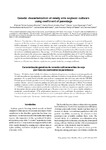Please use this identifier to cite or link to this item:
http://www.alice.cnptia.embrapa.br/alice/handle/doc/470050| Title: | Genetic characterization of ninety elite soybean cultivars using coefficient of parentage. |
| Authors: | MIRANDA, Z. de F. S.  ARIAS, C. A. A.   PRETE, C. E. C.   KIIHL, R. A. de S.   ALMEIDA, L. A. de   TOLEDO, J. F. F. de   DESTRO, D.   |
| Affiliation: | Zilda de Fátima Sgobero Miranda, UEL; Carlos Alberto Arrabal Arias, CNPSo; Cássio Egidio Cavenaghi Prete, UEL; Romeu Afonso de Sousa Kiihl, TMG; Leones Alves de Almeida, CNPSo; José Francisco Ferraz de Toledo, CNPSo; Deonisio Destro, UEL. |
| Date Issued: | 2007 |
| Citation: | Pesquisa Agropecuária Brasileira, Brasília, DF, v. 42, n.3, p. 363-369, mar. 2007. |
| Description: | The objective of this work was to estimate the coefficient of parentage and to understand the genetic structure of 90 elite soybean cultivars, which are adapted to different Brazilian environments. A total of 4,005 coefficients of parentage (f) were obtained and used to group the cultivars by UPGMA method. The constructed dendrogram showed several related cultivar groups which shared similar ancestors and clearly showed the genetic structure of the main Brazilian cultivars. Effective population sizes (Ne) were also estimated for cultivars in different generations. The average f = 0.2124 value, obtained from cultivars classified into four decades according to the release year, suggested effective soybean population sizes of 11 and 13 calculated using arithmetic and weighted means, respectively. The relatively small Ne and the high parentage coefficient support the conclusion that there is a high similarity degree among the main soybean cultivars in Brazil. |
| Thesagro: | Glycine Max |
| Keywords: | Similaridade genética Tamanho efetivo populacional |
| Type of Material: | Artigo de periódico |
| Access: | openAccess |
| Appears in Collections: | Artigo em periódico indexado (CNPSO)  |










